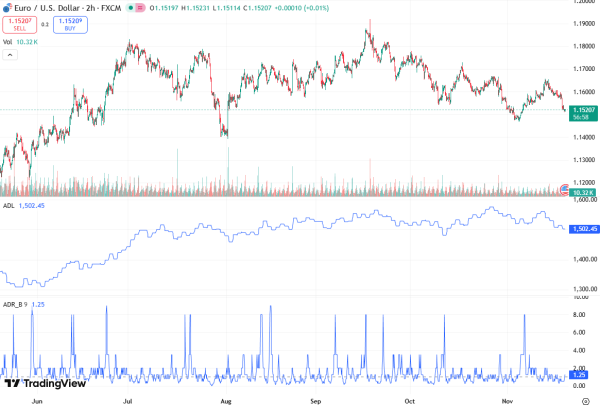The EUR/USD pair remains under close observation by traders and analysts alike as recent market action highlights a nuanced technical outlook. According to UOB Group FX analysts Quek Ser Leang and Peter Chia, the major support at 1.1470 is unlikely to come under immediate threat despite recent volatility.
The Fimatron team presents a comprehensive technical analysis, highlighting short-term fluctuations, key support and resistance levels, and the medium-term bias for EUR/USD.
Short-Term Movements: Testing 1.1500
In the 24-hour view, EUR/USD shows signs of short-term weakness but is expected to remain above the critical support of 1.1470. Analysts had expected EUR/USD to “test 1.1570.” Following this, the pair dropped sharply to 1.1570, confirming a period of increased downward pressure.
EUR/USD hovered around 1.1590, with the view that there was a chance for the pair to test 1.1560. Analysts noted that the major support at 1.1540 was still unlikely to come into play. The recent sharp decline, which broke below 1.1540 to a low of 1.1517, exceeded expectations, highlighting volatility in the short term.
Despite this decline, EUR/USD rebounded from the low, suggesting that the weakness has not yet stabilised. Current analysis indicates that EUR/USD could test 1.1500 before a more sustained rebound occurs. On the upside, resistance levels to monitor are 1.1555 and 1.1575, where potential selling pressure could emerge.
Key Support Levels
The primary support level at 1.1470 remains intact. This level has been tested multiple times earlier in the month but has proven resilient, making it a significant psychological and technical barrier for EUR/USD.
Even with short-term volatility, analysts suggest that it is unlikely for EUR/USD to breach 1.1470 in the immediate term. This support is reinforced by historical price action, where prior declines found strong buying interest near this area. Traders should continue to treat 1.1470 as a critical support zone, with potential rebounds likely if the pair approaches this level.
Medium-Term Bias: Downside Pressure
Looking beyond the 24-hour horizon, the 1-3 week view presents a slightly different picture. On Tuesday, November 18, when EUR/USD was at 1.1590, analysts highlighted that the pair was expected to trade within a range of 1.1540 to 1.1640.
The subsequent sharp drop below 1.1540 has shifted the bias to the downside, although it remains too early to confirm if the pair can revisit the early-month low near 1.1470. This underscores a cautious outlook, where traders are advised to consider both support zones and potential resistance levels carefully.

According to analysts, only a break above 1.1595, considered a strong resistance level, would indicate that the downward bias has faded. Until then, the medium-term outlook suggests that EUR/USD could continue to face selling pressure, with intermittent rebounds potentially capped near 1.1555–1.1575.
Resistance Levels to Watch
For traders seeking short-term entries, monitoring resistance levels is essential. In the current environment, the pair faces resistance at 1.1555, followed by 1.1575. These levels represent short-term supply zones where profit-taking or renewed selling could occur.
The reaction to these resistance levels will be critical in determining whether EUR/USD can maintain a consolidation above 1.1500 or resume its downward trajectory toward 1.1470.

Technical Indicators and Momentum
Recent price action suggests that EUR/USD exhibits momentum swings typical in a volatile consolidation phase. The pair’s failure to hold above 1.1540 earlier reflects short-term bearish pressure, while the subsequent rebound indicates that support zones remain respected.
Traders using moving averages may observe a flattening or mild downward slope, suggesting sideways-to-bearish bias. Additionally, momentum indicators like RSI and MACD could highlight oversold conditions near 1.1500–1.1510, supporting the potential for a short-term rebound before further downside attempts.
Conclusion
In summary, EUR/USD is currently trading under short-term pressure, with a likely test of 1.1500 before any sustained rebound. The major support at 1.1470 remains well-defended, and analysts from UOB Group confirm it is unlikely to come under threat in the near term.
While the medium-term bias has shifted to the downside following the recent break below 1.1540, the outlook remains cautious. Traders should monitor resistance levels at 1.1555 and 1.1575 and be prepared for volatility in the 1-3 week window. Only a sustained move above 1.1595 would suggest that the downward bias has diminished, reinforcing the importance of technical levels in guiding trading decisions.
Overall, EUR/USD continues to demonstrate the delicate balance of supply and demand, highlighting the significance of key support and resistance zones in a volatile forex market.









